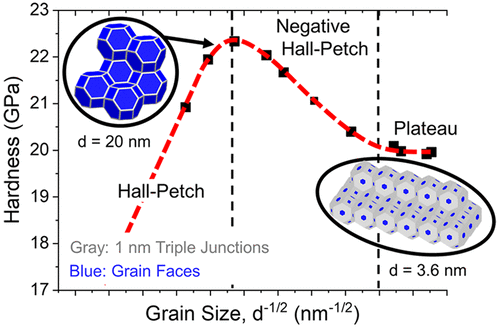Our official English website, www.x-mol.net, welcomes your
feedback! (Note: you will need to create a separate account there.)
Below the Hall–Petch Limit in Nanocrystalline Ceramics
ACS Nano ( IF 15.8 ) Pub Date : 2018-03-01 00:00:00 , DOI: 10.1021/acsnano.7b07380 Heonjune Ryou 1 , John W. Drazin 1 , Kathryn J. Wahl 2 , Syed B. Qadri 3 , Edward P. Gorzkowski 3 , Boris N. Feigelson 4 , James A. Wollmershauser 3
ACS Nano ( IF 15.8 ) Pub Date : 2018-03-01 00:00:00 , DOI: 10.1021/acsnano.7b07380 Heonjune Ryou 1 , John W. Drazin 1 , Kathryn J. Wahl 2 , Syed B. Qadri 3 , Edward P. Gorzkowski 3 , Boris N. Feigelson 4 , James A. Wollmershauser 3
Affiliation

|
Reducing the grain size of metals and ceramics can significantly increase strength and hardness, a phenomenon described by the Hall–Petch relationship. The many studies on the Hall–Petch relationship in metals reveal that when the grain size is reduced to tens of nanometers, this relationship breaks down. However, experimental data for nanocrystalline ceramics are scarce, and the existence of a breakdown is controversial. Here we show the Hall–Petch breakdown in nanocrystalline ceramics by performing indentation studies on fully dense nanocrystalline ceramics fabricated with grain sizes ranging from 3.6 to 37.5 nm. A maximum hardness occurs at a grain size of 18.4 nm, and a negative (or inverse) Hall–Petch relationship reduces the hardness as the grain size is decreased to around 5 nm. At the smallest grain sizes, the hardness plateaus and becomes insensitive to grain size change. Strain rate studies show that the primary mechanism behind the breakdown, negative, and plateau behavior is not diffusion-based. We find that a decrease in density and an increase in dissipative energy below the breakdown correlate with increasing grain boundary volume fraction as the grain size is reduced. The behavior below the breakdown is consistent with structural changes, such as increasing triple-junction volume fraction. Grain- and indent-size-dependent fracture behavior further supports local structural changes that corroborate current theories of nanocrack formation at triple junctions. The synergistic grain size dependencies of hardness, elasticity, energy dissipation, and nanostructure of nanocrystalline ceramics point to an opportunity to use the grain size to tune the strength and dissipative properties.
中文翻译:

低于纳米晶陶瓷的霍尔提取极限
减小金属和陶瓷的晶粒尺寸可以显着提高强度和硬度,这种现象由霍尔-帕奇(Hall-Petch)关系描述。关于金属中Hall-Petch关系的许多研究表明,当晶粒尺寸减小到几十纳米时,这种关系就会破裂。但是,纳米晶陶瓷的实验数据稀少,并且是否存在击穿是有争议的。在这里,我们通过对晶粒度从3.6到37.5 nm的全致密纳米晶陶瓷进行压痕研究,显示了纳米晶陶瓷中的Hall-Petch击穿。最大硬度出现在晶粒尺寸为18.4 nm处,并且当晶粒尺寸减小到5 nm左右时,负(或反向)的Hall-Petch关系会降低硬度。在最小的晶粒尺寸下,硬度趋于平稳,并且对晶粒尺寸的变化不敏感。应变速率研究表明,击穿,负向和平稳行为背后的主要机制不是基于扩散的。我们发现,随着晶粒尺寸的减小,在击穿以下时密度的降低和耗散能的增加与晶界体积分数的增加相关。击穿以下的行为与结构变化一致,例如增加了三结体积分数。晶粒和压痕尺寸相关的断裂行为进一步支持了局部结构变化,从而证实了当前在三重结处形成纳米裂纹的理论。硬度,弹性,能量耗散,
更新日期:2018-03-01
中文翻译:

低于纳米晶陶瓷的霍尔提取极限
减小金属和陶瓷的晶粒尺寸可以显着提高强度和硬度,这种现象由霍尔-帕奇(Hall-Petch)关系描述。关于金属中Hall-Petch关系的许多研究表明,当晶粒尺寸减小到几十纳米时,这种关系就会破裂。但是,纳米晶陶瓷的实验数据稀少,并且是否存在击穿是有争议的。在这里,我们通过对晶粒度从3.6到37.5 nm的全致密纳米晶陶瓷进行压痕研究,显示了纳米晶陶瓷中的Hall-Petch击穿。最大硬度出现在晶粒尺寸为18.4 nm处,并且当晶粒尺寸减小到5 nm左右时,负(或反向)的Hall-Petch关系会降低硬度。在最小的晶粒尺寸下,硬度趋于平稳,并且对晶粒尺寸的变化不敏感。应变速率研究表明,击穿,负向和平稳行为背后的主要机制不是基于扩散的。我们发现,随着晶粒尺寸的减小,在击穿以下时密度的降低和耗散能的增加与晶界体积分数的增加相关。击穿以下的行为与结构变化一致,例如增加了三结体积分数。晶粒和压痕尺寸相关的断裂行为进一步支持了局部结构变化,从而证实了当前在三重结处形成纳米裂纹的理论。硬度,弹性,能量耗散,











































 京公网安备 11010802027423号
京公网安备 11010802027423号